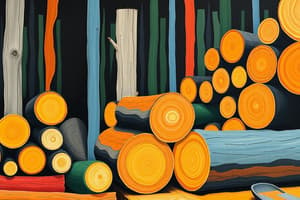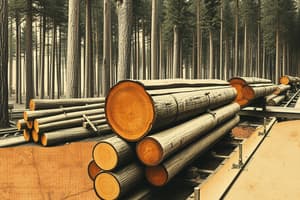Podcast
Questions and Answers
Lumbering consists of three phases: logging, driving, and manufacturing.
Lumbering consists of three phases: logging, driving, and manufacturing.
False (B)
In Canada, lumbering is primarily conducted during the winter months.
In Canada, lumbering is primarily conducted during the winter months.
True (A)
About 40 percent of Canada is covered with deciduous forests.
About 40 percent of Canada is covered with deciduous forests.
False (B)
Canada is the leading exporter of wood products in the world.
Canada is the leading exporter of wood products in the world.
The most significant trees used in lumbering in Canada are oak and maple.
The most significant trees used in lumbering in Canada are oak and maple.
During the winter, logs are left piled above frozen rivers waiting for the ice to melt.
During the winter, logs are left piled above frozen rivers waiting for the ice to melt.
The wood from coniferous trees is hard and difficult to cut.
The wood from coniferous trees is hard and difficult to cut.
Farmers in Canada often become full-time lumberjacks during the summer months.
Farmers in Canada often become full-time lumberjacks during the summer months.
Cutting down primary trees leads to the loss of seeds for new trees to grow.
Cutting down primary trees leads to the loss of seeds for new trees to grow.
Trees prevent soil erosion by allowing nutrients to wash away easily.
Trees prevent soil erosion by allowing nutrients to wash away easily.
Without trees, flooding and mud-slides can happen and cause environmental damage.
Without trees, flooding and mud-slides can happen and cause environmental damage.
Sediment from erosion can cause rivers and streams to clear, benefiting fish reproduction.
Sediment from erosion can cause rivers and streams to clear, benefiting fish reproduction.
Trees release carbon dioxide into the atmosphere when they are cut down, contributing to global warming.
Trees release carbon dioxide into the atmosphere when they are cut down, contributing to global warming.
Lumbering is the largest industry in Canada.
Lumbering is the largest industry in Canada.
Hardwood trees are characterized by needle-like leaves.
Hardwood trees are characterized by needle-like leaves.
British Columbia produces roughly one-third of Canada's softwood lumber supply.
British Columbia produces roughly one-third of Canada's softwood lumber supply.
Lumberjacks are traditionally seen as symbols of strength and masculinity.
Lumberjacks are traditionally seen as symbols of strength and masculinity.
Softwood trees lose their leaves in winter.
Softwood trees lose their leaves in winter.
The lumber industry in Canada opened up during the 20th century.
The lumber industry in Canada opened up during the 20th century.
Particle board is an example of a product created by the lumber industry.
Particle board is an example of a product created by the lumber industry.
Sawn lumber and square timber were not major staples of the wood industry.
Sawn lumber and square timber were not major staples of the wood industry.
Bucking logs is the first stage in the typical sequence of operations for processing trees into lumber.
Bucking logs is the first stage in the typical sequence of operations for processing trees into lumber.
Lumbering is typically carried out in summer when the sap flows.
Lumbering is typically carried out in summer when the sap flows.
Oriented strand board was formerly called flake board.
Oriented strand board was formerly called flake board.
The logs are cut into appropriate sizes by a process known as cutting.
The logs are cut into appropriate sizes by a process known as cutting.
Birch, maple, and oak are predominant hardwood species in Canada.
Birch, maple, and oak are predominant hardwood species in Canada.
Modern machinery has made logging a predominantly female domain.
Modern machinery has made logging a predominantly female domain.
Lumbering can lead to loss of biodiversity in the environment.
Lumbering can lead to loss of biodiversity in the environment.
Flashcards are hidden until you start studying
Study Notes
Lumbering Overview
- Lumbering refers to tree cutting for wood production in domestic, industrial, or commercial sectors.
- The four phases of lumbering are logging, driving, manufacturing, and transport.
- Logging is typically limited to winter months when snow and ice facilitate transportation.
Logging Process
- Logs are dragged by horses or oxen over snow-covered terrains to collection points.
- Driving is the movement of logs from collection points to sawmills, utilizing railroads when necessary.
- Manufacturing cuts logs into lumber products such as planks and boards, primarily for construction and paper.
- Transport includes finding buyers and delivery to markets, with local mills selling to nearby residents.
Lumbering in Canada
- Canada, rich in coniferous forests, covers about 40% of its land area with these resources.
- Major forests extend from Newfoundland to British Columbia, facilitating extensive lumber production.
- Canada is the world's leading wood products exporter, contributing to one-third of global lumber and timber markets.
- Lumbering is a significant winter activity; logs are temporarily stored on frozen rivers for spring transport.
Tree Species
- Lumber is produced from hardwood (e.g., oak, maple, birch) and softwood (e.g., pine, fir, spruce) trees.
- Canadian forestry is dominated by softwood species, specifically spruce, pine, and hemlock, primarily harvested in British Columbia.
- Hardwood lumber production is concentrated in Ontario and Quebec.
Lumbering Products
- Key products include lumber, veneer, plywood, particle board, wood pellets, and engineered wood.
- Manufacturing processes involve mechanical methods such as sawing and peeling.
Manufacturing Process
- Inspection involves cleaning logs and checking for defects before processing.
- Debarking uses high-powered jets or cutting blades to remove bark, often repurposed for decoration.
- Logs are cut into sizes (bucking logs) for various uses, with water sprayed to avoid drying.
- Cutting and edging involve optical sensors and computer mapping for optimal cuts, with manual oversight.
- Planing and grading prepare the wood, ensuring quality before packaging and shipment.
Factors Favoring Lumbering
- Limited species of coniferous trees are well-suited for winter logging.
- Frozen ground facilitates easier transport of logs to rivers for floating to sawmills.
- Access to hydroelectricity enhances sawmill operation in mountainous regions, supporting efficient lumbering.
Life of a Lumberjack
- Lumberjacks epitomize strength and masculinity in Canada, crucial to the timber industry since its rise.
- In the 19th century, half of Canadian males were lumberjacks; modern machinery now allows female participation.
Environmental Effects of Lumbering
- Biodiversity Loss: Habitat destruction threatens species survival and ecosystems reliant on primary trees.
- Erosion: The loss of trees leads to soil degradation and nutrient loss, making environments barren.
- Flooding: Deforestation compromises soil stability, increasing risks of floods and mudslides, endangering lives and properties.
- River Obstruction: Soil erosion leads to sedimentation in rivers, disrupting aquatic habitats critical for species like salmon.
- Climate Change: Deforestation releases stored carbon, increasing greenhouse gas concentrations and contributing to global warming's adverse effects, including extreme weather events.
Studying That Suits You
Use AI to generate personalized quizzes and flashcards to suit your learning preferences.




